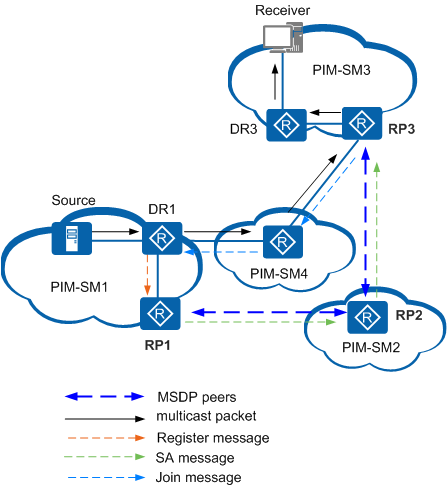Inter-domain Multicast Source Information Transmission
As shown in Figure 1, a PIM-SM network is divided into four PIM-SM domains. There is an active multicast source (Source) in domain PIM-SM1, and RP1 knows this source after the source registers to it. Domains PIM-SM2 and PIM-SM3 need to obtain the exact position of this source to receive multicast data from it. MSDP peer relationships must be set up between RP1 and RP2, and between RP2 and RP3.
Multicast source information is transmitted between domains as follows:
- When Source in PIM-SM1 sends the first multicast packet to the multicast group, the designated router DR1 encapsulates multicast data to a register message and sends the message to RP1. RP1 then obtains information about this multicast source.
- As the source RP, RP1 periodically sends SA messages to its peer RP2. The SA messages contain the multicast source address S, the group address G, and the address of RP1 that creates the SA messages.
- After receiving an SA message, RP2 performs a reverse path forwarding (RPF) check. If the message passes the RPF check, RP2 forwards it to RP3 and checks whether group G has members in the local domain. Because PIM-SM2 contains no receiver of group G, RP2 does not perform any other action.
- After RP3 receives the SA message, it performs an RPF check, and the message passes the check. Because a member of group G exists in PIM-SM3, RP3 generates an IGMP (*, G) entry.
- RP3 creates an (S, G) entry and sends a Join message with (S, G) information to Source. The Join message is transmitted hop by hop, so that a shortest path tree (SPT) from Source to RP3 is set up. When multicast data reaches RP3 along the SPT, RP3 forwards the data to the receiver along the RPT.
- After DR3 (receiver DR) receives multicast data from Source, it determines whether to trigger an SPT switchover.
